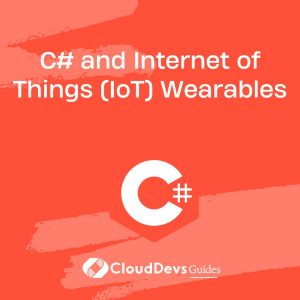C# and Internet of Things (IoT) Wearables
Table of Contents
The Internet of Things (IoT) is revolutionizing how we interact with everyday objects, making them smarter and more connected. Wearable devices, a key segment of IoT, are increasingly popular in healthcare, fitness, and entertainment. C# provides a robust framework for developing and managing these IoT wearables, offering powerful tools and libraries to create connected, responsive, and efficient devices.

Understanding IoT Wearables
IoT wearables are smart devices worn on the body, capable of connecting to the internet and interacting with other devices and systems. These wearables collect data, provide insights, and offer users real-time feedback. Key applications include fitness trackers, smartwatches, and health monitoring devices.
Using C# for IoT Wearable Development
C# is an excellent choice for developing IoT wearables due to its strong type system, extensive libraries, and seamless integration with hardware and cloud services. Below are key aspects of using C# in IoT wearable development, including practical code examples.
1. Connecting to IoT Devices
Establishing reliable communication between the wearable and other devices is crucial. C# offers libraries like `System.Net` and `Microsoft.Azure.Devices.Client` for managing connections and data exchange.
Example: Connecting to an IoT Hub
Here’s how you can connect a wearable device to an IoT Hub using C#.
```csharp
using System;
using Microsoft.Azure.Devices.Client;
using System.Text;
using System.Threading.Tasks;
class Program
{
private static DeviceClient deviceClient;
private readonly static string connectionString = "your-iot-hub-connection-string";
static async Task Main()
{
deviceClient = DeviceClient.CreateFromConnectionString(connectionString, TransportType.Mqtt);
await SendMessageToCloudAsync("Device connected.");
}
private static async Task SendMessageToCloudAsync(string message)
{
var messageBytes = new Message(Encoding.ASCII.GetBytes(message));
await deviceClient.SendEventAsync(messageBytes);
Console.WriteLine($"Sent message: {message}");
}
}
```
2. Collecting and Processing Sensor Data
Wearable devices often rely on sensors to collect data such as heart rate, steps, or temperature. C# allows you to interface with these sensors, process the data, and perform actions based on the collected information.
Example: Reading Data from a Heart Rate Sensor
Here’s a simple example of how you might read heart rate data from a wearable sensor.
```csharp
using System;
class HeartRateMonitor
{
public event EventHandler<int> OnHeartRateChanged;
public void StartMonitoring()
{
Random random = new Random();
while (true)
{
int heartRate = random.Next(60, 100); // Simulated data
OnHeartRateChanged?.Invoke(this, heartRate);
System.Threading.Thread.Sleep(1000); // Simulate 1-second intervals
}
}
}
class Program
{
static void Main()
{
HeartRateMonitor monitor = new HeartRateMonitor();
monitor.OnHeartRateChanged += (sender, heartRate) =>
Console.WriteLine($"Heart Rate: {heartRate} bpm");
monitor.StartMonitoring();
}
}
```
3. Visualizing Wearable Data
Data visualization is essential for making the collected data from wearables meaningful to users. C# can be used with libraries like `OxyPlot` or `LiveCharts` to create interactive dashboards and graphs.
Example: Visualizing Step Count Data
Here’s how you might visualize step count data using C#.
```csharp
using OxyPlot;
using OxyPlot.Series;
using System;
class Program
{
static void Main()
{
var plotModel = new PlotModel { Title = "Daily Step Count" };
var series = new LineSeries { Title = "Steps" };
// Sample data
var data = new[] { 5000, 7000, 8000, 9000, 10000 };
for (int i = 0; i < data.Length; i++)
{
series.Points.Add(new DataPoint(i, data[i]));
}
plotModel.Series.Add(series);
// Code to render the plot would go here
}
}
```
4. Integrating with Cloud Services
IoT wearables often require integration with cloud services for data storage, analytics, and management. C# provides excellent support for cloud platforms like Microsoft Azure.
Example: Sending Data to Azure IoT Central
Here’s an example of how to send data from a wearable to Azure IoT Central.
```csharp
using System;
using System.Text;
using System.Threading.Tasks;
using Microsoft.Azure.Devices.Client;
class Program
{
private static DeviceClient deviceClient;
private readonly static string connectionString = "your-iot-central-connection-string";
static async Task Main()
{
deviceClient = DeviceClient.CreateFromConnectionString(connectionString, TransportType.Mqtt);
await SendTelemetryDataAsync("StepCount", 10234);
}
private static async Task SendTelemetryDataAsync(string telemetryName, int value)
{
var messageString = $"{{ \"{telemetryName}\": {value} }}";
var message = new Message(Encoding.ASCII.GetBytes(messageString));
await deviceClient.SendEventAsync(message);
Console.WriteLine($"Sent telemetry data: {messageString}");
}
}
```
Conclusion
C# is a powerful language for developing and managing IoT wearables, offering a comprehensive set of tools for connecting devices, processing sensor data, visualizing information, and integrating with cloud services. By leveraging these capabilities, developers can create innovative and reliable IoT wearables that enhance users’ lives.



